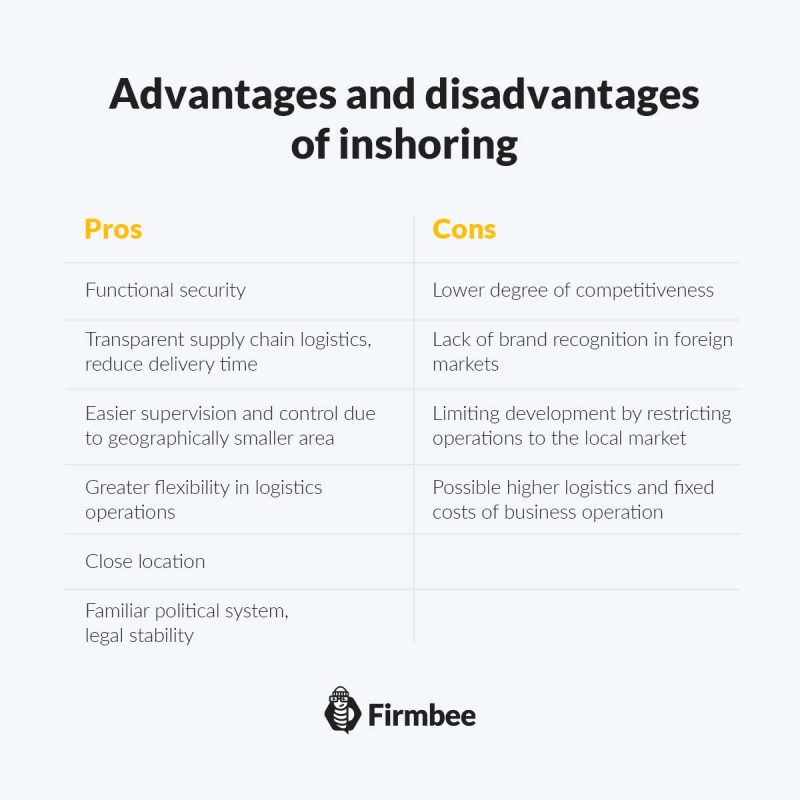What are offshoring and inshoring? Dynamic changes in the world economy and globalization processes affect the functioning of companies. Companies are increasingly deciding to expand to foreign markets, in search of cheaper labor and cheaper means of production. The decision to locate a company’s subsidiary abroad is associated not only with new opportunities to create sales of products and services but also with the search for new sources of material resources. A phenomenon directly related to these processes is offshoring, popular business practice understood as the transfer of selected functions or business processes to foreign markets. When the expansion does not bring the expected results and benefits, companies decide to return to the home country under the so-called inshoring.
Offshoring vs inshoring – table of contents:
How do you define offshoring and inshoring?
The phenomenon of offshoring was initiated in the United States in the late 1970s. One of the forerunners in this field was General Electric, which moved production overseas from the US. We can divide offshoring into two categories:
- Nearshoring – Relocation of operations to neighboring countries, such as from Germany to Poland.
- Farshoring – Relocation of operations to remote countries, such as from Europe to East Asia.
Offshoring is defined as the transfer of part of an enterprise’s activities in the field of services or production abroad, in order to reduce costs and improve the quality and increase the efficiency of the mechanisms implemented. The transfer can take the form of expanding its own structures or entering into cooperation with external foreign entities. In order to maximize the optimization of the process, we should consider offshoring in the category of long-term goals.
Short-term actions may result in small benefits and administrative complications. Offshoring should be considered as a choice at the strategic level, not at the operational level, because the consequence changes in all areas of management and decision-making (centralization, decentralization) related to coordination, control, with changes in structure and allocation of resources.

Inshoring is the opposite of offshoring and means moving business processes to a less expensive location within the country. It is most economically advantageous to move logistics operations as close as possible to where the company’s markets are served. Reverse offshoring is justified when foreign suppliers or manufacturers are no longer competitive with domestic suppliers. This is especially true when labor costs increase in external markets or the price of specific internal economy services decreases.
When looking for new organizational and logistical solutions, companies choose inshoring, mainly because of the possibility of working with local, cheaper cooperators. The choice of this strategy is mainly influenced by the situation on global markets, government regulations, technology development and global competition.

Offshoring vs inshoring. Which to choose?
The above summary shows that offshoring and inshoring have both benefits and potential risks. Consequently, a universal solution is impossible to indicate. The choice of an appropriate option for strategic action in this regard depends on several factors, such as the long-term goals set by the company, available resources and financial means, and economic and legal conditions.
On the one hand, offshoring increases the availability of low-cost labor, but on the other hand, cultural differences and operating in different time zones might significantly increase costs. Inshoring may offset these costs in favor of higher employee benefits, but this increases the risk of slowing growth and reducing the company’s degree of competitiveness.
Summary
The selection of the location of manufacturing or service activities and the decision to offshore or inshore should be preceded by an extensive analysis of available resources, financial and material resources, organizational and legal conditions, development opportunities, and the construction of a flexible supply chain. Changing economic conditions, including fluctuating labor costs and the increase in global competitiveness are forcing flexible forms of operation on market participants. Therefore, it is common for companies to relocate to foreign markets and, in the case of recession and global crisis, to return to the domestic market. It is important that the actions taken are rational and do not significantly disrupt the core business of the company.
Read also: Emerging markets – pros & risks
If you like our content, join our busy bees community on Facebook, Twitter, LinkedIn, Instagram, YouTube, Pinterest.
Author: Andy Nichols
A problem solver with 5 different degrees and endless reserves of motivation. This makes him a perfect Business Owner & Manager. When searching for employees and partners, openness and curiosity of the world are qualities he values the most.


















